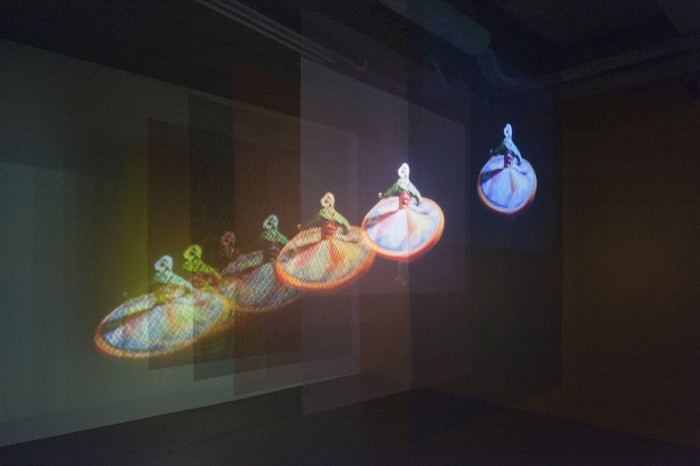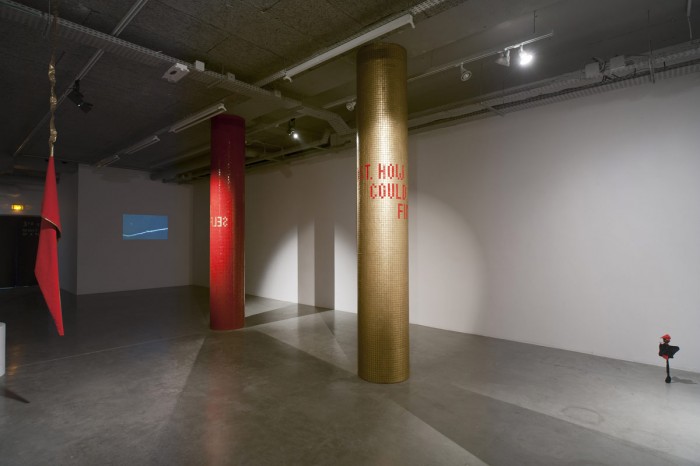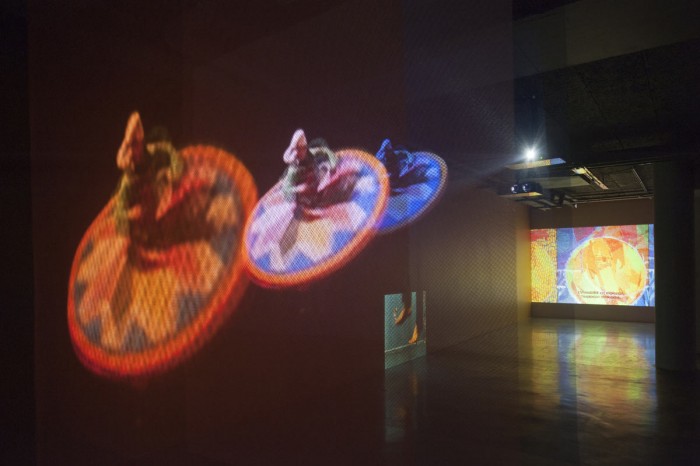Exhibition curator : Xavier Franceschi
The FRAC Ile-de-France / Le Plateau is presenting Through Somnambular Laws[1], the first exhibition in Paris of the work of Elise Florenty and Marcel Türkowsky, which is devoted essentially to their recent output. Since they started working together, these two artists have shared the same fascination with the poetic power of language, through fables, spells and instructions. For this exhibition, they involve visitors in strolling in spaces punctuated by systems and instructions for an immersion to be lived through, like the crossing of a history governed by underground laws.
An almost schizophrenic immersion, through the encounter and exchange of different viewpoints, where otherness is experienced in a twofold assertion: the self and the other, the ego and the enemy, the quick and the dead…
Time thus seems suspended, frozen between explosion and motionlessness. Various repetitions (of language and gesture) convey thoughts prey to delirium or akin to a daze. These thoughts are haunted by legendary or ordinary figures, waiting for a movement, or an awakening. A sort of “art of resurrection”, insofar as the two artists stick closely to the precept of the German playwright Heiner Müller: “…the dialogue with the dead must not be broken as long as they have not given back that part of the future that has been buried with them.”
For Le Plateau, they have jointly made several new films. Holy Time in Eternity, Holy Eternity in Times sets out in search of Faulkner’s imaginary county, “Yoknapatawpha” in Mississippi, where rivers, forests and huts are all filled with—and shedding—beings and phenomena wavering between normality and surreality, actuality and timelessness.
A história sem história (na hora da decisão), based on a letter written by Lygia Clark and some of Glauber Rocha’s[2] films, follows the meeting between two men on the Brazilian shore: one seems to be bringing the other back to life, but it is this latter who turns out to be livelier in recollecting a buried ideal, an absolute quest, and an irrational revolt, which leads him consciously and repeatedly to his downfall.
Der Stillstand ist die Explosion, die Explosion der Stillstand (WIR der gefrorene Sturm)[3] makes a crossing in “a time wall”. The words—exchanged by telephone—are cut-ups of poetic and theoretical writings by Heiner Müller, and the images are close-ups of a mosaic dating from East German days, depicting the conquest of space or, rather, “a dead star on which a rescue team from another day and age, or another space, hears a voice and discovers a corpse.”
Different viewpoints which question the “temporal breaks” displayed by the eruption of one world into another, one system into another. They dwell on complex, often paradoxical characters, like anonymous anti-heroes, at once anti-social (outlaws) but also indispensable to society.
Through Somnambular Laws dictates a slowed-down reading process and introduces a fluidity where there is no reason to tell imagination and reality apart. This twosome mixes factual elements with factors borrowed from literature, film, music, theatre and dance, which they get to dialogue together, using ricochets. In the exhibition’s last room, using this logic, they have come up with a performance-related space where there is a stand-off between the geometric figures of a Beckett play (Quad – a square) and a Gurdjieff [4] ballet (the enigmatic figure of the Enneagram – a figure (gramme) with nine (ennea) points). Just like in their films and installations, the ideas of strolling (from one point to another) and displacement (from the self to the other) culminate in a set of actions, a praxis – as opposed to a contemplation – which once again questions being-together.
Elise Florenty (*1978 in Pessac) and Marcel Türkowsky (*1978 in former East Berlin) both live and work in Berlin. Their recent shows include: “Life Ticket”, Les Eglises, Chelles art centre (2009-2010) and “Wheels of Memory”, La Synagogue art centre, Delme (2009), as well as the group exhibitions “The Eleventh Letter”, at the BKV Potsdam e.V., Germany (2010/2011), “Void of Memory”, Platform 2009, Seoul.
[1] Oswald de Andrade, Anthropophagous Manifesto, 1928
[2] Leader of the cinema novo, the brazilian’s new wave
[3] ICH der gefrorene Sturm (literally translated: I the frozen storm) is the last word in Heiner Müller’s Description of a Picture : it alludes to Walter Benjamin’s angel of history turned towards the past and caught in the storm of progress. H.M.’s storm, for its part, is frozen, caught in a process of slowing-down, etc. It is the storm of resurrection. The frozen storm is a metaphor of the expectation of movement. H.M.’s angel is buried in ruins, turned to stone, transfixed, frozen, but you can still hear its wings flapping under the stones.
[4] Georges Gurdjieff (of Armenian origin, 1877-1949), a famous figure of esotericism.
Slide show







